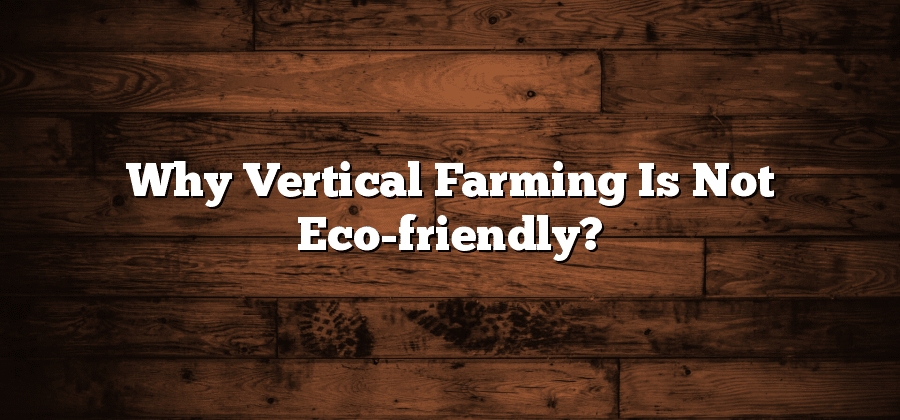Environmental Implications of Vertical Farming
Vertical farming is an innovative and promising approach to agriculture that aims to address the global challenges of food insecurity and environmental sustainability. By growing crops in vertically stacked layers, using artificial lighting and climate-controlled environments, vertical farming can maximize the use of limited space and minimize the need for traditional soil-based farming methods. However, like any agricultural system, vertical farming also has environmental implications that need to be carefully considered.
One major concern is the energy consumption associated with vertical farming systems. The use of artificial lighting, heating, and cooling systems can result in significant energy requirements. This can lead to increased carbon emissions and contribute to climate change. Therefore, it is crucial for vertical farms to adopt energy-efficient technologies and renewable energy sources to minimize their environmental footprint. Additionally, optimizing the design and operation of vertical farming systems can help reduce energy consumption without compromising crop productivity.
Energy Consumption in Vertical Farming Systems
Vertical farming systems have been lauded for their potential to reduce the energy consumption typically associated with traditional farming practices. By utilizing controlled environments, these systems allow for optimized lighting, temperature, and humidity settings that can enhance plant growth while minimizing energy wastage. However, it is important to note that the energy requirements of vertical farming systems can vary significantly depending on factors such as the size of the operation, the choice of lighting technology, and the level of automation used.
One of the primary sources of energy consumption in vertical farming systems is artificial lighting. Since crops grown in vertical farms lack access to natural sunlight, high-intensity artificial lighting systems are employed to provide adequate light for photosynthesis. LEDs (light-emitting diodes) are commonly used due to their energy efficiency and long lifespan. Other lighting technologies, such as fluorescent and high-pressure sodium lights, are also utilized but tend to consume more energy. The constant operation of these lighting systems, often for extended periods, contributes to the overall energy consumption of vertical farming systems.
To manage energy consumption, vertical farms are exploring various strategies, such as using natural light whenever possible and incorporating smart lighting systems that adjust intensity and duration based on plant needs. Additionally, advances in solar panels and energy storage technologies are being explored to harness sustainable energy sources for powering vertical farms. Achieving a balance between the energy requirements of vertical farming systems and environmental sustainability remains a challenge, but continuous research and technological advancements hold promise for more energy-efficient operations in the future.
Water Usage and Waste in Vertical Farms
Water usage and waste management are critical factors to consider in vertical farming systems. The efficient use of water resources is vital as vertical farms aim to maximize food production in limited spaces. However, vertical farms typically require large amounts of water for irrigation, as crops are grown in a controlled environment without the natural water supply like rainfall.
To mitigate water consumption in vertical farms, various techniques and technologies can be employed. For instance, hydroponic systems, which involve growing plants in nutrient-rich water, can reduce water usage compared to traditional soil-based agriculture. Additionally, the implementation of advanced irrigation systems, such as drip irrigation or fogging systems, can help minimize water waste and ensure that plants receive the necessary moisture without excess runoff. Moreover, the recycling and reusing of water within vertical farming systems can further optimize water usage and reduce overall demand.
Impact of Synthetic Fertilizers and Pesticides
Synthetic fertilizers and pesticides have long been utilized in conventional agricultural practices to enhance crop yields and protect against pest infestations. However, their use comes at a cost to both human health and the environment. The impact of synthetic fertilizers and pesticides on the environment is multifaceted and warrants serious consideration.
One of the primary concerns surrounding the use of synthetic fertilizers is the risk of nutrient runoff. When these fertilizers are applied excessively or during rain events, the excess nutrients can find their way into water bodies, leading to eutrophication. Eutrophication, characterized by an excessive growth of algae and subsequent depletion of dissolved oxygen, can have detrimental effects on aquatic ecosystems. Additionally, the widespread use of pesticides has been linked to the decline of pollinator populations, such as bees, which play a crucial role in the pollination of many food crops. As these negative impacts become more evident, the need for alternative farming methods, such as vertical farming, becomes increasingly important.
Challenges in Waste Management of Vertical Farms
Vertical farming offers numerous benefits in terms of efficient land use and reduced carbon emissions. However, it also presents challenges in waste management that need to be addressed for the sustainable operation of these farms. One major concern is the disposal of organic waste generated during the cultivating process.
Vertical farming systems rely on organic materials like peat moss or coco coir as growing mediums, which are abundant during the farming process. Once these materials are depleted, they become waste that needs to be managed appropriately. Improper disposal of organic waste can lead to increased methane emissions and potential water contamination. Therefore, finding effective and environmentally friendly solutions for managing this waste is crucial. Composting, for example, can be a viable method for recycling organic waste and transforming it into nutrient-rich fertilizer for future crops. Implementing strict waste management protocols, such as proper sorting and disposal systems, can help reduce the environmental impact of waste generated in vertical farms.






